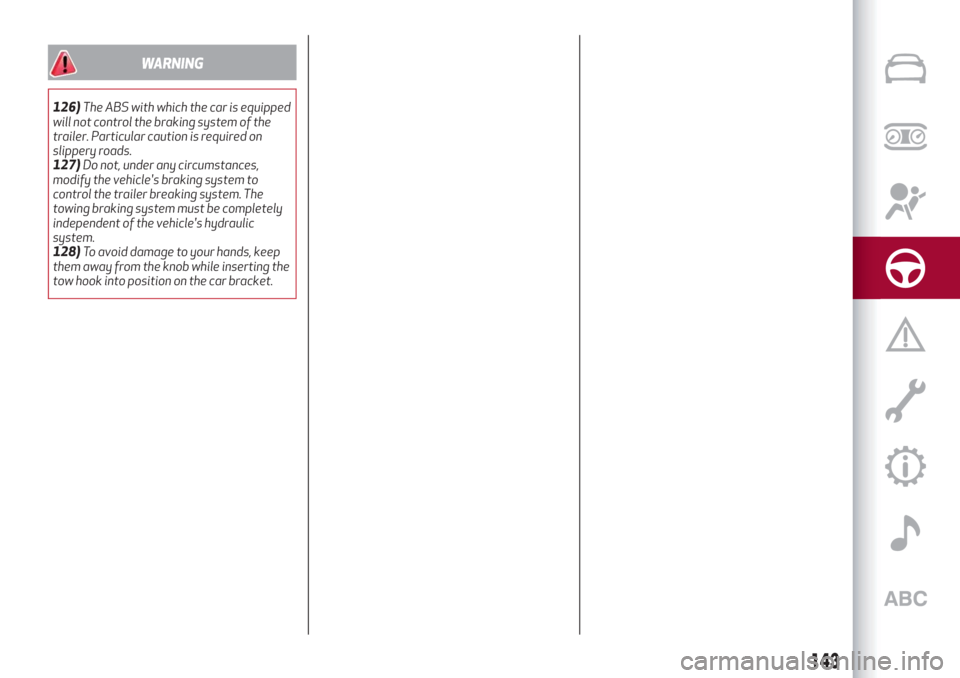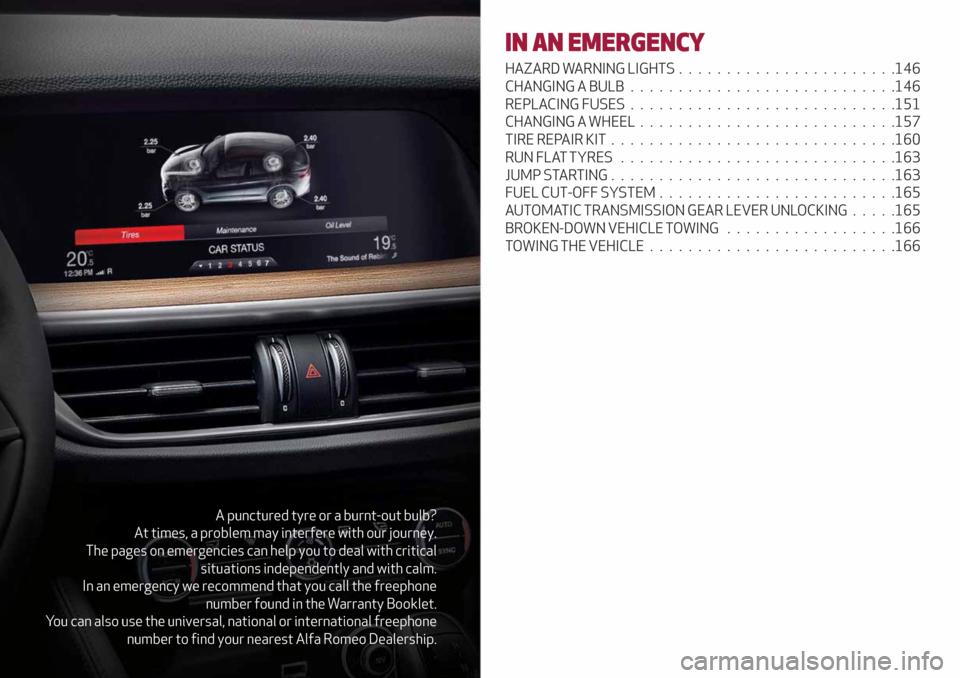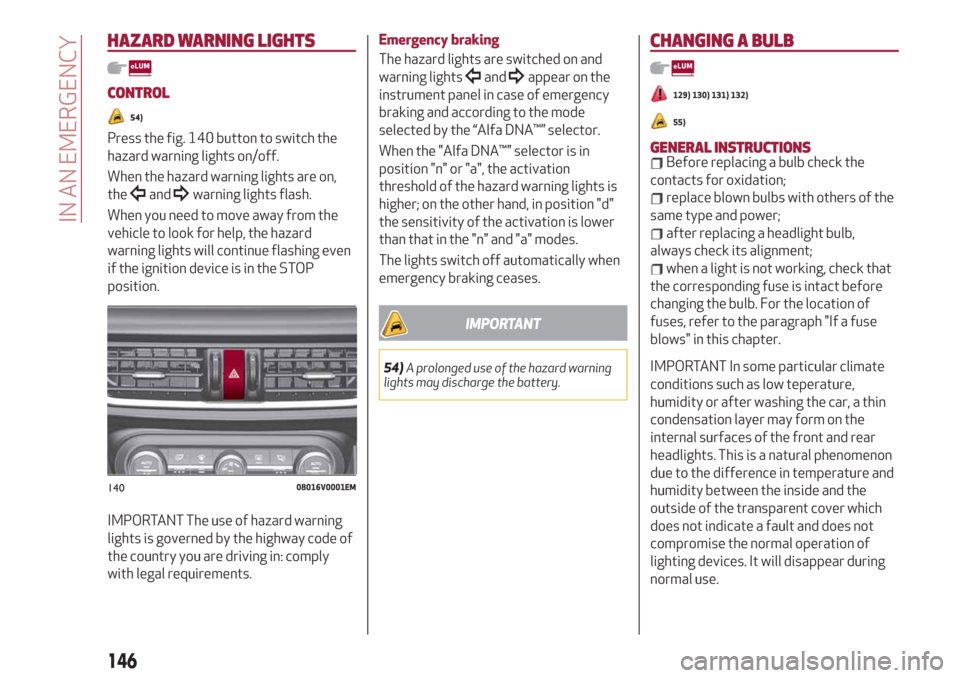2019 Alfa Romeo Stelvio warning
[x] Cancel search: warningPage 137 of 244

Versions with Cargo Box and
space-saver spare wheel
(where provided)
Proceed as follows:
open the tailgate and then lift up the
load bed fig. 122;
undo the locking device 1 fig. 125 and
extract the space-saver spare wheel to
reach the emergency opening cable 1
fig. 126 positioned on the side of the
filler;
pull the cord to unlock the fuel flap;
open the fuel flap by pressing it.
IMPORTANT If the filler compartment is
washed with a high-pressure jet, keep it
at a distance of at least 8 in (20 cm).
WARNING
122)Do not apply any object/plug to the
end of the filler which is not provided for the
car. The use of non-compliant objects/plugs
could cause a pressure increase inside the
tank, resulting in dangerous situations.
123)Do not bring naked flames or lit
cigarettes near to the fuel filler: fire risk.
Keep your face away from the fuel filler to
prevent breathing in harmful vapours.
124)Do not use a mobile phone near the
refuelling pump: risk of fire.
125)If the AdBlue overheats for a
prolonged period inside the tank to over 50
°C (for example, due to direct solar
irradiation), the AdBlue may decompose and
produce ammonia vapours. Ammonia
vapours have a pungent odour when the cap
of the AdBlue tank is unscrewed, therefore
be careful not to inhale any ammonia
vapours in the tank outlet. In this
concentration, however, the ammonia
vapors are not harmful or dangerous to
health.
12407226V0043EM
12508066V0010EM
12607226V0044EM
135
Page 138 of 244

AdBlue® (UREA) ADDITIVE FOR
DIESEL EMISSIONS
(2.2 JTD versions only)
The car is equipped with an UREA
injection system and Selective Catalytic
Reduction to meet emission standards.
These two systems ensure compliance
with the diesel emissions requirements;
at the same time, they ensure
fuel-efficiency, handling, torque and
power. For messages and system
warnings, refer to the "Warning lights and
messages" paragraph in the "Knowing the
instrument panel" chapter.
AdBlue® (UREA) is considered a very
stable product with a long shelf life.
Stored at temperatures LOWER than
89.6° F (32 °C), it has a shelf life of at
least one year.
For more information on the AdBlue®
liquid type, see the “Fluids and lubricants”
paragraph in the “Technical
specifications” chapter.
The car is provided with an automatic
AdBlue® heating system when the engine
starts allowing the system to work
correctly at temperatures lower
than -11 °C.
IMPORTANT AdBlue® freezes at
temperatures lower than 12.2 °F (-11 °C).
SUGGESTIONS FOR DRIVING
SAVING FUEL
Below are some suggestions which may
help you save fuel and thus lower the
amount of harmful emissions released
into the atmosphere.
Vehicle maintenance
Checks and operations should be carried
out in accordance with the "Scheduled
Servicing Plan" (see chapter
"Maintenance and care").
Tyres
Check the tyre pressures at least once
every four weeks: if the pressure is too
low, consumption levels increase as
resistance to rolling is higher.
Unnecessary loads
Do not travel with an overloaded boot.
The weight of the vehicle and its
arrangement greatly affect fuel
consumption and stability.
Electric devices
Use electrical devices only for the
amount of time needed. The heated rear
window, additional headlights, screen
wipers and heater fan require a
considerable amount of energy;
increasing the current uptake increases
fuel consumption (by up to +25% in an
urban cycle).Climate control system
Using the climate control system will
increase consumption: use standard
ventilation when the temperature
outside permits.
Devices for aerodynamic control
The use of non-certified devices for
aerodynamic control may adversely
affect air drag and consumption levels.
DRIVING STYLE
Starting
Do not warm up the engine at low or high
revs when the vehicle is stationary; this
causes the engine to warm up more
slowly, thereby increasing fuel
consumption and emissions. It is
therefore advisable to move off
immediately, slowly, avoiding high
speeds: in this way the engine will warm
up more quickly.
Unnecessary actions
Avoid revving up when starting at traffic
lights or before stopping the engine. The
latter action, as well as double-
declutching, is unnecessary and causes
increased fuel consumption and
pollution.
Gear selection
Use a high gear when traffic and road
conditions allow it. Using a low gear for
faster acceleration will increase fuel
136
STARTING AND DRIVING
Page 145 of 244

WARNING
126)The ABS with which the car is equipped
will not control the braking system of the
trailer. Particular caution is required on
slippery roads.
127)Do not, under any circumstances,
modify the vehicle's braking system to
control the trailer breaking system. The
towing braking system must be completely
independent of the vehicle's hydraulic
system.
128)To avoid damage to your hands, keep
them away from the knob while inserting the
tow hook into position on the car bracket.
143
Page 147 of 244

A punctured tyre or a burnt-out bulb?
At times, a problem may interfere with our journey.
The pages on emergencies can help you to deal with critical
situations independently and with calm.
In an emergency we recommend that you call the freephone
number found in the Warranty Booklet.
You can also use the universal, national or international freephone
number to find your nearest Alfa Romeo Dealership.
IN AN EMERGENCY
HAZARD WARNING LIGHTS.......................146
CHANGING A BULB............................146
REPLACING FUSES . ...........................151
CHANGING A WHEEL ...........................157
TIRE REPAIR KIT . .............................160
RUN FLAT TYRES.............................163
JUMP STARTING..............................163
FUEL CUT-OFF SYSTEM . ........................165
AUTOMATIC TRANSMISSION GEAR LEVER UNLOCKING.....165
BROKEN-DOWN VEHICLE TOWING..................166
TOWING THE VEHICLE..........................166
Page 148 of 244

HAZARD WARNING LIGHTS
CONTROL
54)
Press the fig. 140 button to switch the
hazard warning lights on/off.
When the hazard warning lights are on,
the
andwarning lights flash.
When you need to move away from the
vehicle to look for help, the hazard
warning lights will continue flashing even
if the ignition device is in the STOP
position.
IMPORTANT The use of hazard warning
lights is governed by the highway code of
the country you are driving in: comply
with legal requirements.
Emergency braking
The hazard lights are switched on and
warning lights
andappear on the
instrument panel in case of emergency
braking and according to the mode
selected by the “Alfa DNA™” selector.
When the "Alfa DNA™" selector is in
position "n" or "a", the activation
threshold of the hazard warning lights is
higher; on the other hand, in position "d"
the sensitivity of the activation is lower
than that in the "n" and "a" modes.
The lights switch off automatically when
emergency braking ceases.
IMPORTANT
54)A prolonged use of the hazard warning
lights may discharge the battery.
CHANGING A BULB
129) 130) 131) 132)
55)
GENERAL INSTRUCTIONSBefore replacing a bulb check the
contacts for oxidation;
replace blown bulbs with others of the
same type and power;
after replacing a headlight bulb,
always check its alignment;
when a light is not working, check that
the corresponding fuse is intact before
changing the bulb. For the location of
fuses, refer to the paragraph "If a fuse
blows" in this chapter.
IMPORTANT In some particular climate
conditions such as low teperature,
humidity or after washing the car, a thin
condensation layer may form on the
internal surfaces of the front and rear
headlights. This is a natural phenomenon
due to the difference in temperature and
humidity between the inside and the
outside of the transparent cover which
does not indicate a fault and does not
compromise the normal operation of
lighting devices. It will disappear during
normal use.
14008016V0001EM
146
IN AN EMERGENCY
Page 153 of 244

WARNING
129)Before replacing the bulb, wait for the
exhaust ducts to cool down: DANGER OF
SCALDING!
130)Modifications or repairs to the electric
system that are not carried out properly or
do not take the system technical
specifications into account can cause
malfunctions leading to the risk of fire.
131)Halogen bulbs contain pressurised gas,
in the case of breakage they may burst
causing glass fragments to be projected
outwards.
132)Only replace the light bulbs when the
engine is off and in a position that does not
interfere with traffic and lets you safely
replace them (see the description in the
“Replacement” paragraph). Also ensure that
the engine is cold, to prevent the risk of
burns.
IMPORTANT
55)Halogen bulbs must be handled holding
the metallic part only. Touching the
transparent part of the bulb with your
fingers may reduce the intensity of the
emitted light and even reduce the lifespan of
the bulb. In the event of accidental contact,
wipe the bulb with a cloth moistened with
alcohol and let the bulb dry.
REPLACING FUSES
INTRODUCTION
133) 134) 135) 136) 137)
56) 57)
Fuses protect the electrical system: they
intervene (blow) in the event of a failure
or improper action on the system.
Fuse extracting pliers
To replace a fuse, use the pliers hooked
to the boot fusebox cover fig. 150.
Grab the pliers from the upper tabs,
press them and extract the pliers pulling
upwards.
The pliers fig. 151 have two different
ends, specifically designed to remove the
different types of fuses present in the
vehicle:
1: MINI fuse;
2: J-CASE fuse.After use, refit the pliers in position,
proceeding as follows:
grasp the pliers from the upper tabs;
press the pliers in their housing,
pushing downwards, until they click into
place.
FUSE LOCATION
The fuses, which can be replaced by the
user, are grouped in two boxes below the
passenger side foot board and inside the
boot.
CONTROL UNIT UNDER PASSENGER
SIDE FOOTBOARD
To access the fuses, proceed as follows:
lift the upper end of the footboard 1
fig. 152 on the passenger side, pulling it
to release the 2 buttons;15008036V0053EM
15108036S0005EM
151
Page 159 of 244

WARNING
133)Never replace a fuse with another with
a higher amp rating; DANGER OF FIRE.
134)Before replacing a fuse, make sure
that the ignition device is at STOP and that
all devices are switched off and/or
disconnected.
135)Contact an Alfa Romeo Dealership if a
safety system (airbags, brakes),
transmission system (engine, gearbox) or
steering system general protection fuse
blows.
136)If a fuse blows again, contact an Alfa
Romeo Dealership.
137)If a general protective fuse
(MAXI-FUSE, MEGA-FUSE, MIDI-FUSE)
blows, contact an Alfa Romeo Dealership.
IMPORTANT
56)Never replace a fuse with metal wires or
anything else.
57)If it is necessary to wash the engine
compartment, take care not to directly hit
the fuse box and the window wiper motors
with the water jet.
CHANGING A WHEEL
GENERAL INSTRUCTIONS
The car is equipped with the "Tire Repair
Kit": see the “Tire Repair Kit” paragraph
for how to use this device.
As an alternative to the “Tire Repair Kit”,
the car may be requested with a
space-saver wheel: see the instructions
on the following pages for changing the
wheel.
JACK
138) 139)
Please note that:
the jack weighs about 4.4 lb (2 kg);
the jack requires no adjustment;
the jack cannot be repaired and in the
event of a fault it must be replaced by
another genuine one;
no tool other than its cranking device
may be fitted on the jack.
Jack maintenance:
prevent any dirt from depositing on
the "worm screw";
keep the "worm screw" lubricated;
never modify the jack.
Conditions in which not to use the jack:
temperatures below −40°F (-40°C);
on sandy or muddy ground;
on uneven ground;
on steep slopes in extreme weather
conditions: thunderstorms, typhoons,hurricanes, blizzards, storms, etc.;
in direct contact with the engine or for
repairs under the car;
on boats.
CHANGING PROCEDURE
140) 141) 142) 143) 144) 145) 146)
58) 59)
Proceed as follows:
stop the car in a position that is not
dangerous for oncoming traffic where
you can change the wheel safely.
The ground must be flat and
sufficiently compact;
stop the engine, engage the hazard
warning lights and the parking brake;
engage P (Park) mode;
wear the reflective safety jacket
(compulsory by law) before getting out of
the car;
open the luggage compartment and lift
up the mat using the handle;
when the situation dictates it (for your
own safety and to comply with the
regulations in force in the country where
you are), take the warning triangle and
position it at a suitable distance from the
car;
unscrew the locking device 1 fig. 157,
take out the space-saver wheel and the
inflation compressor;
157
Page 161 of 244

hose fitting 6 fig. 161;
make sure that the switch 8 on the
compressor 6 is in the 0 (off) position,
open the rear hatch and insert the plug
into the power socket in the luggage
compartment or on the central tunnel and
start the engine. Put the switch 8 in the I
(on) position;
inflate the space-saver wheel to a
pressure of 43.5 psi (3 bar);
IMPORTANT To conserve the battery
charge, it is recommended to leave the
vehicle running for the entire inflation
process.
To obtain a more accurate reading, it is
advisable to check the pressure of the
space-saver wheel on the pressure gauge
7 with the compressor off.
The compressor was designed
exclusively for inflating the space-saverwheel. Do not use it for inflating
mattresses, rafts, etc.
operate the extension lever 2 on the
jack 4 to lower the car;
then remove the jack 4;
use the wrench 3 to fully tighten the
bolts, passing alternately from one bolt
to the diagonally opposite one.
When replacing an alloy wheel, it is
advisable to place it upside down, with
the aesthetic part facing upwards.
WARNING
138)The jack may be used to replace
wheels only on the car that it comes with or
other cars of the same model. Never use the
jack for other purposes, such as lifting other
vehicle models. Never use it for repair
operations under the vehicle. Incorrect
positioning of the jack may cause the vehicle
to fall. Do not use the jack for loads higher
than the one shown on its label. Never install
snow chains on the space-saver wheel; if a
front tyre (driving wheel) is punctured and
you need to use snow chains, use a standard
wheel from the rear axle and install the
space-saver wheel on the rear axle. In this
way, with two normal front drive wheels, it is
possible to use snow chains.139)The jack is a tool developed and
designed only for changing a wheel, if a tyre
gets punctured or damaged, on the vehicle
with which it is supplied or on other vehicles
of the same model. Any other use, e.g. to jack
up other vehicle models or different things,
is strictly prohibited. Never use for
maintenance or repair activities under the
car or to exchange the summer/winter
wheels and vice versa. Never go under the
raised vehicle. Should it be necessary to
work under the vehicle, contact an Alfa
Romeo Dealership. Incorrect positioning of
the jack may cause the raised vehicle to fall:
use only in the positions indicated. Do not
use the jack for loads higher than the one
shown on its label. Never start the engine
with vehicle raised. If the vehicle is raised
more than necessary, everything can
become more unstable, with the risk of the
vehicle dropping violently. Thus, lift the
vehicle only as needed in order to access the
spare wheel.
140)The space-saver wheel is specific for
your car. Do not use it on cars of different
models. Do not use space-saver wheels of
different models on your car. The
space-saver wheel must only be used in the
event of an emergency. Never use it for more
than strictly necessary and never exceed
80 km/h. On the space-saver wheel there is
an orange label, summarising the main
warnings regarding space-saver wheel
usage restrictions. Never remove or cover
the label. Never apply any hub cap to the
space-saver wheel.
16108066V0011EM
159